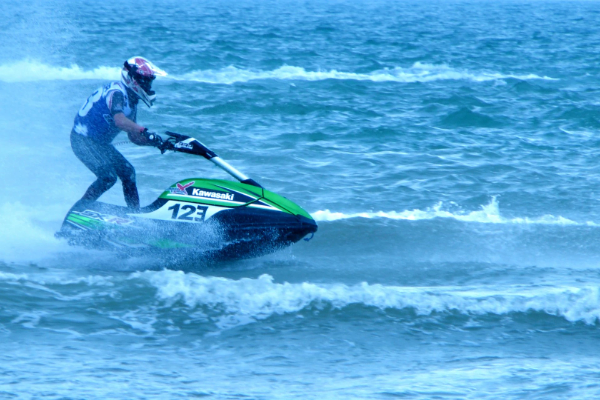Running a jet ski out of water is a necessary skill for maintenance, troubleshooting, and winterizing your watercraft. However, it’s crucial to do it correctly to avoid damaging your jet ski’s engine or other components. This guide will cover everything you need to know about running a jet ski out of water, including the necessary precautions, step-by-step procedures, and essential maintenance tips.
Why Run a Jet Ski Out of Water?
- Maintenance and Inspection: Running a jet ski out of water allows for thorough inspection and maintenance. You can check for leaks, clean the engine, and ensure everything is in working order.
- Winterization: Preparing your jet ski for winter involves running it out of water to flush out any remaining water in the engine and cooling system.
- Troubleshooting: Diagnosing engine problems can be easier when the jet ski is out of water. You can listen for unusual noises and observe the engine’s performance.
- Flushing the Engine: After riding in saltwater, running the jet ski out of water helps flush out salt, sand, and debris from the cooling system.
Precautions and Safety Measures
- Avoid Overheating: Jet skis rely on water to cool their engines. Running a jet ski out of water for too long can cause the engine to overheat and damage it. Keep the running time short.
- Use a Flushing Kit: A flushing kit connects to your garden hose and allows water to flow through the engine while it’s running out of water. This prevents overheating and cleans the cooling system.
- Stable Surface: Ensure your jet ski is on a stable surface, like a jet ski stand or trailer, to prevent it from tipping over.
- Proper Ventilation: Run the jet ski in a well-ventilated area to avoid inhaling exhaust fumes.
- Regular Checks: Monitor the engine temperature and other indicators to ensure everything is functioning correctly.
Step-by-Step Guide to Running a Jet Ski Out of Water
- Preparation: Place your jet ski on a secure stand or trailer in a well-ventilated area. Ensure the area is clear of flammable materials.
- Connect the Flushing Kit: Attach the flushing kit to your garden hose. Ensure the connection is secure to prevent leaks.
- Turn on the Water: Turn on the water supply before starting the jet ski. This ensures water is flowing through the engine immediately to prevent overheating.
- Start the Engine: Start the jet ski’s engine. Allow it to run for a short period (usually no more than 1-2 minutes) while monitoring the engine temperature and water flow.
- Inspect the Engine: While the engine is running, listen for unusual noises and check for any signs of leaks or issues.
- Turn Off the Engine: After the short run, turn off the engine first. Then, turn off the water supply. This sequence prevents water from backflowing into the engine.
- Disconnect the Flushing Kit: Remove the flushing kit and ensure no water is left in the hoses or the engine.
- Final Inspection: Conduct a final inspection of the jet ski to ensure everything is in order.
Common Mistakes to Avoid
- Running Too Long: Never run the jet ski out of water for more than a few minutes. Overheating can cause severe engine damage.
- Improper Flushing Kit Use: Ensure the flushing kit is properly connected and water is flowing before starting the engine.
- Neglecting Maintenance: Regular maintenance is crucial. Don’t skip inspections and cleaning after each use.
- Ignoring Warning Signs: Pay attention to any unusual noises, leaks, or performance issues. Address them promptly to avoid more significant problems.
- Poor Ventilation: Always run the jet ski in a well-ventilated area to avoid exhaust fumes.
Maintenance Tips
- Regular Flushing: After each use, especially in saltwater, flush the engine with fresh water to remove salt, sand, and debris.
- Oil Changes: Regularly change the engine oil according to the manufacturer’s recommendations.
- Inspect Hoses and Connections: Check all hoses, clamps, and connections for wear and tear. Replace any damaged components.
- Battery Maintenance: Keep the battery charged and clean. Check for corrosion on the terminals and clean them if necessary.
- Fuel System Care: Use a fuel stabilizer if you won’t use the jet ski for an extended period. Regularly check the fuel lines for leaks or cracks.
Troubleshooting Common Issues
- Engine Overheating: If the engine overheats, turn it off immediately. Check the water flow and ensure the flushing kit is properly connected. Allow the engine to cool before restarting.
- Unusual Noises: Investigate any unusual noises. They could indicate loose components or internal issues that need addressing.
- Poor Performance: If the jet ski isn’t performing well, check the fuel system, spark plugs, and air filters. Clean or replace components as needed.
- Leaks: Look for any signs of water or fuel leaks. Tighten connections or replace damaged hoses to fix leaks.
Winterizing Your Jet Ski
- Final Flush: Perform a final flush of the engine to remove any remaining water.
- Fuel Stabilizer: Add a fuel stabilizer to the gas tank to prevent fuel degradation over the winter.
- Oil Change: Change the engine oil and filter to ensure fresh oil is in the engine during storage.
- Battery Care: Remove the battery and store it in a cool, dry place. Keep it charged over the winter.
- Cover and Store: Cover your jet ski with a protective cover and store it in a dry, sheltered location.
See Also: How to Get Better at Paddle Boarding
Conclusion
Running a jet ski out of water is essential for maintenance, troubleshooting, and winterization. By following the correct procedures and precautions, you can ensure your jet ski remains in excellent condition and ready for the water. Regular maintenance and careful handling will extend the life of your watercraft and provide you with many more enjoyable rides.

